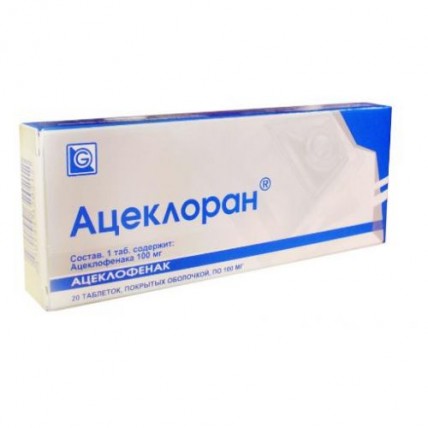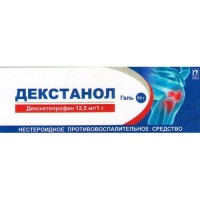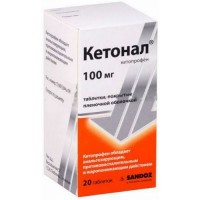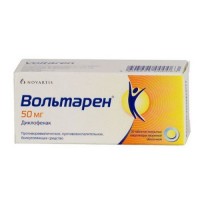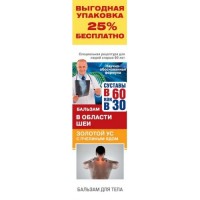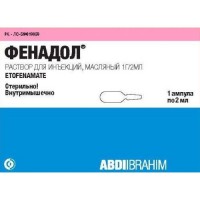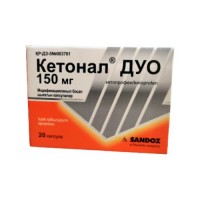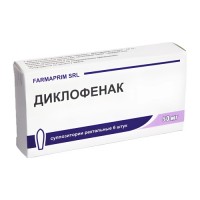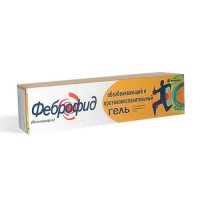Atsekloran 20s 100 mg coated tablets
- $15.70
The instruction for medical use of Atsekloran® medicine the Trade name of Atsekloran® the International unlicensed name Atseklofenak Lekarstvennaya the Tablet form, coated, 100 mg Structure One tablet contains active agent - atseklofenak 100 mg, excipients: lactoses monohydrate, potato starch, hydroxypropyl cellulose, magnesium stearate, sodium of starch glikolit, calcium carboxymethylcellulose structure of a cover: gipromelloza 2910, polyethyleneglycol 6000, titan dioxide (E 171). The description of the Tablet, coated white color, round cylindrical shape with a biconvex surface. Pharmacotherapeutic group Anti-inflammatory and antirheumatic drugs. Non-steroidal anti-inflammatory drugs. Acetic acid derivatives. Atseklofenak the ATX M01AB16 Code the Pharmacological Pharmacokinetics Absorption Later properties of intake atseklofenak is quickly soaked up, its bioavailability is nearly 100%. The maximum plasma concentration is reached from about 1.25 to 3 hours later after reception. Meal slows down absorption, but does not influence its degree. Distribution Atseklofenak highly contacts proteins of plasma (& gt, 99.7%). Atseklofenak gets into synovial fluid where its concentration reaches about 60% of its concentration in plasma. The volume of distribution is about 30 l. Removal Average elimination half-life makes 4-4.3 hours. The clearance is 5 l/h. About two thirds of the accepted dose are removed with urine, generally in the form of the conjugated hydroxies metabolites. Only 1% of a single oral dose is removed in not changed look. Atseklofenak is perhaps metabolized by CYP2C9 in the main metabolite 4-OH-atseklofenak whose contribution to clinical effect of drug, most likely, is minimum. Diclofenac and 4-OH-diclofenac were found among many metabolites. Special populations elderly patients have no differences in pharmacokinetics of an atseklofenak. Slower removal of an atseklofenak was observed at patients from the liver lowered by function after single use of drug. In a research of repeated use at reception of 100 mg differences in pharmacokinetic parameters at participants with cirrhoses of a liver of easy or moderate degree and healthy volunteers were not observed once a day. At patients with renal failures of easy or moderate degree clinically significant differences in pharmacokinetic indicators after single dose were not observed. A pharmacodynamics Atseklofenak is a nonsteroid means with the anti-inflammatory and anesthetizing effects. It is considered that the mechanism of effect of this drug is based on prostaglandin synthesis inhibition. Indications Symptomatic treatment of a painful symptom and inflammation in the osteoarthritis, a pseudorheumatism, an ankylosing spondylarthritis and other diseases of the musculoskeletal system which are followed by pain (for example, a humeroscapular periarthritis and other extraarticular manifestations of rheumatism) the Anesthetizing action at the states which are followed to painful symptoms (such as lumbar, a toothache and primary dysmenorrhea) the Route of administration and doses Drug is intended for intake, the tablet should be swallowed entirely, washing down with at least a half of a glass of water. The concomitant use of food slows down the speed of absorption of active ingredient, however does not reduce extent of absorption from zheludochno – an intestinal path. Adults the Maximum recommended dose makes 200 mg a day, in two separate receptions on 100 mg (one tablet in the morning and one evening). Children children have no data on efficiency and safety of administration of drug therefore it is not recommended to apply at children aged up to 18 years. Elderly patients Usually are not present need for reduction of a dose, however observance of precautionary measures is necessary. Patients with a liver failure the Dose of an atseklofenak should be reduced at patients with diseases of a liver of weak or moderate degree. The recommended initial dose makes 100 mg a day. Patients with a renal failure patients have no data on need for reduction of a dose of an atseklofenak with a renal failure of easy degree, but it is necessary to be careful at drug Atsekloran® use. Duration of a course of treatment is established individually, depending on a nosological form of a disease and expressiveness of clinical manifestations. Side effects the Majority of usually observed by-effects are disturbances from digestive tract. There can be a stomach ulcer, a perforation or bleeding from a GIT sometimes leading to a lethal outcome, especially at elderly patients. At intake of non-steroidal anti-inflammatory drugs (NPVP) the nausea, vomiting, diarrhea, intestines swelling, a constipation, dyspepsia, a stomach ache, a melena, a hematemesis, a stomacace, exacerbation of colitis and Crohn's disease were observed. Gastritis was less often observed. Due to the reception of NPVP it was reported about edematization, arterial hypertension and heart failure. Some NPVP (especially at reception of high doses and prolonged use) can slightly increase risk of the arterial trombotichesky phenomena (for example, a myocardial infarction or a stroke). Often (from ≥1/100 to & lt, 1/10) - dizziness - nausea, dyspepsia, an abdominal pain, diarrhea - increase in activity of hepatic enzymes Infrequently (from ≥1/1000 to & lt, 1/100) - vomiting, intestines swelling, a constipation, ulcerations of a mucous membrane of an oral cavity, gastritis - an itching, rash, dermatitis, urticaria - increase in concentration of urea and creatinine of serum in blood is rare (from ≥1/10000 to & lt, 1/1000) - anemia - anaphylactic reactions (including shock), hypersensitivity - a disorder of vision - arterial hypertension, deterioration in a course of arterial hypertension, heart failure - dispnoe - a melena, ulcerations mucous digestive tract, hemorrhagic diarrhea, zheludochno – intestinal bleeding - a Quincke's disease Very seldom (& lt, 1/10000) - oppression of activity of marrow: the granulocytopenia, thrombocytopenia, a neutropenia, hemolytic anemia - a hyperpotassemia - a depression, unusual dreams, insomnia - paresthesia, a tremor, drowsiness, a headache, a dysgeusia (food faddism) - vertigo, a ring in ears - heart consciousness - a dermahemia, inflows, a vasculitis - a bronchospasm - stomatitis, a hematemesis, an intestines perforation, deterioration in the course of the disease Krone and ulcer colitis, pancreatitis - injury of a liver (including hepatitis), increase in activity of alkaline phosphatase in blood - a purpura, eczema, heavy reactions from skin and mucous membranes (including Stephens-Johnson's syndrome and a toxic epidermal necrolysis) - a nephrotic syndrome, a renal failure, interstitial nephrite - increased fatigue, muscular spasms (in legs), hypostasis - increase in body weight In special cases, were observed serious skin infections and infections of soft tissues at reception of NPVP during a disease of chicken pox. Contraindications - hypersensitivity to an atseklofenak or to any of auxiliary components of drug - patients at whom drugs with similar action (for example, acetylsalicylic acid or other non-steroidal anti-inflammatory drugs (NPVP)) provoked attacks of asthma, a bronchospasm, acute rhinitis or small tortoiseshell or if there is a hypersensitivity to these substances - patients who had cases an active, expected or recurrent round ulcer or ulcer/bleeding of a duodenum in the anamnesis (two or more separate episodes of the confirmed stomach ulcer or intestines, or bleeding) - patients with acute, recurrent or possible ulcer of stomach or duodenum, or bleeding in the anamnesis (two or more obvious and proved episode of an ulcer or bleeding) - patients with the acute bleeding or diseases which are followed by bleedings (hemophilia or disturbances of blood clotting) - heart failure (functional class II-IV on NYHA), coronary heart disease, diseases of peripheral arteries or cerebrovascular diseases. - pregnancy and the period of a lactation - children's and teenage age up to 18 years Medicinal interactions Atseklofenak is metabolized by means of P450 2C9 cytochrome, and these in vitro show what atseklofenak can be inhibitor of this enzyme. Thus, the risk of pharmacokinetic interaction is possible at a concomitant use with Phenytoinum, Cimetidinum, tolbutamide, phenylbutazone, Amiodaronum, Miconazolum and sulfafenazoly. As well as in a case with other drugs of NPVP-group, the risk of pharmacokinetic interaction with other drugs which are removed from an organism by active renal secretion, such as methotrexate and drugs of lithium also increases. Atseklofenak almost completely contacts albumine of plasma and, therefore, there is a possibility of interactions as replacement with other drugs contacting proteins. Because of a lack of researches of pharmacokinetic interaction of an atseklofenak the following information is based on data on other NPVP: It is necessary to avoid simultaneous use: Methotrexate: NPVP inhibit canalicular secretion of a methotrexate, moreover, small metabolic interaction can be observed that leads to reduction of clearance of a methotrexate. Therefore at use of high doses of a methotrexate it is necessary to avoid purpose of NPVP. Drugs of lithium and digoxin: some NPVP inhibit renal clearance of lithium and digoxin that leads to increase in concentration in serum of both substances. It is necessary to avoid combined use if frequent monitoring of concentration of lithium and digoxin is not carried out. Anticoagulants: NPVP inhibit aggregation of thrombocytes and injure a mucous membrane of digestive tract that can lead to strengthening of effect of anticoagulants and increase risk of bleeding from digestive tract at the patients accepting anticoagulants. It is necessary to avoid combined use of an atseklofenak and oral anticoagulants of coumarinic group, a tiklopidin and trombolitik if careful monitoring of a condition of the patient is not carried out. Antiagregantny means and selective serotonin reuptake inhibitors (SSRIs) at combined use with NPVP can increase risk of bleeding from digestive tract. The following combinations demand selection of a dose and use with care: Methotrexate: it must be kept in mind possible interaction of NPVP and methotrexate, even at a low dose of a methotrexate, especially at patients with renal failures. At a concomitant use it is necessary to control indicators of function of kidneys. It is necessary to be careful if both drugs, NPVP and a methotrexate, were accepted within 24 hours as concentration of a methotrexate can increase that will increase toxicity of this drug. Cyclosporine, takrolimus: at a concomitant use of NPVP with cyclosporine or takrolimusy it is necessary to consider risk of the increased nephrotoxicity because of decrease in formation of renal prostacyclin. Therefore at a concomitant use it is necessary to control indicators of function of kidneys carefully. Other NPVP: at a concomitant use of acetylsalicylic acid or other NPVP the frequency of emergence of by-effects therefore it is necessary to be careful can increase. Corticosteroids: the risk of developing of an ulcer or bleeding from digestive tract increases. Diuretics: atseklofenak, as well as other NPVP, the activity of diuretics can inhibit, can reduce diuretic effect of furosemide and a bumetanid and antihypertensive effect of tiazid. To lead joint reception with kaliysberegayushchy diuretics to increase in content of potassium, therefore, it can is necessary to control regularly potassium content in blood serum. Atseklofenak did not influence control of arterial blood pressure at combined use with bendrofluazidy though it is impossible to exclude interactions with other diuretics. Hypotensive drugs: NPVP can reduce effect of hypotensive drugs also. Joint intake of APF inhibitors or antagonists of receptors of angiotensin II and NPVP can lead to a renal failure. The risk of developing of an acute renal failure which usually has reversible character can increase at some patients with renal failures, for example, at the elderly or dehydrated patients. Therefore at combined use it is necessary to be careful with NPVP, especially at elderly patients. Patients have to consume necessary amount of liquid and be under the corresponding observation (control of function of kidneys at the beginning of combined use and periodically during treatment). Hypoglycemic means: diclofenac can be applied together with oral hypoglycemic means without influence on their clinical effect. However there are separate messages about hypoglycemic and hyper glycemic effects of drug. Thus, at reception of an atseklofenak it is necessary to carry out correction of doses of drugs which can cause a hypoglycemia. Zidovudine: at a concomitant use of NPVP and a zidovudine the risk of hematologic toxicity increases. HIV have data on increase in risk of developing of a hemarthrosis and hematomas (+) the patients with hemophilia receiving a zidovudine and an ibuprofen. Special instructions It is necessary to avoid a concomitant use of Atseklorana® and other NPVP, including selection inhibitors of cyclooxygenase-2. The undesirable phenomena can be minimized by use of a minimal effective dose and reduction of duration of the treatment necessary for achievement of control of symptoms of a disease. Influence on digestive tract Bleeding, an ulcer or a perforation of a GIT with a lethal outcome were observed at reception of any NPVP during any period of treatment, both in the presence of dangerous symptoms, and without them as in the presence in the anamnesis of serious morbid conditions of a GIT, and without them. The risk of bleeding, ulceration and a perforation of a GIT increases with increase in a dose of NPVP at patients at whom the ulcer was observed, especially if it was followed by hemorrhage or a perforation and at elderly patients. These patients should accept a drug minimal effective dose. Combination therapy using drugs protectors is necessary for them (for example, mizoprostol, or inhibitors of a proton pomp), also similar therapy is necessary for patients who accept small doses of aspirin or other drugs which have negative effect on a condition of digestive tract. Patients with gastrointestinal diseases, including elderly, have to report about any unusual symptoms connected with a GIT (especially bleeding), including at primary administration of drug. The extra care should be observed to the patients who are at the same time taking the drugs which can increase risk of developing of bleeding or ulcer, such as system corticosteroids, anticoagulants (such as warfarin), selective serotonin reuptake inhibitors or antiagregant (such as acetylsalicylic acid). When developing bleeding or ulcer of a GIT at the patients accepting Atsekloran®, treatment has to be cancelled. Influence on cardiovascular and blood supply of a brain with arterial hypertension and/or stagnant heart failure of easy or moderate degree are necessary For patients: the corresponding monitoring and special instructions as it was reported about a liquid delay in the organism and hypostases associated with reception of NPVP. Use of some NPVP (in particular, in high doses and at prolonged use) can insignificantly increase risk of the arterial trombotichesky phenomena (for example, a myocardial infarction or a stroke). There are no reliable data about lack of this risk at reception of an atseklofenak. Patients with uncontrollable arterial hypertension, the stagnant heart failure established by coronary heart disease, atherosclerosis of peripheral arteries and/or disturbance of cerebral circulation should observe extra care at reception of an atseklofenak. The extra care before the first reception also should be observed to patients with risk factors for a cardiovascular system (for example, arterial hypertension, a lipidemia, diabetes and smoking). Atseklofenak it is necessary to take with caution and under observation of the doctor patsy
there at states stated below as there is a threat of exacerbation of a disease: - the symptoms demonstrating presence of a disease of digestive tract including his upper and lower parts - existence in the anamnesis of an ulcer, bleeding or perforation of digestive tract - ulcer colitis - Crohn's disease - hematologic diseases, SLE (system lupus erythematosus), a porphyria, and it is necessary to apply disturbances of a hematopoiesis of Atsekloran® with care and under observation of the doctor to patients with a hemorrhagic stroke in the anamnesis. Influence on a liver and kidneys Reception of NPVP can cause a dose-dependent reduction of formation of prostaglandin and a sudden renal failure. Importance of prostaglandin for providing a renal blood-groove should be considered at administration of drug at patients with dysfunction of heart, kidneys or a liver, at the persons receiving diuretics or at patients after surgical intervention and also at elderly patients. It is necessary to be careful at administration of drug at patients with abnormal liver functions and kidneys of easy or moderate degree and also at patients with other states contributing to a liquid delay in an organism. At these patients use of NPVP can lead to a renal failure and to a liquid delay. Also it is necessary to be careful at reception of Atsekloran® at the patients accepting diuretics or persons with the increased risk have hypovolemia. The minimal effective dose and regular medical control of function of kidneys is necessary. The phenomena from kidneys are usually resolved after the termination of reception of an atseklofenak. Reception of an atseklofenak should be stopped if changes of indicators of function of a liver remain or worsen, develop clinical signs or symptoms of diseases of a liver, or there are other manifestations (eosinophilia, rash). Hepatitis can develop without prodromal symptoms. Use of NPVP for patients with a hepatic porphyria can provoke exacerbation of a disease. The hypersensitivity and skin reactions As well as other NPVP, drug can cause allergic reactions, including anaphylactic/anaphylactoid reactions even if the drug is taken for the first time. Heavy skin reactions (some of which can be led to a lethal outcome), including exfoliative dermatitis, Stephens-Johnson's syndrome and a toxic epidermal necrolysis. The highest risk of emergence of these reactions at patients is observed at the beginning of administration of drug, also development of these undesirable reactions is observed within the first month of administration of drug. When developing skin rash, damages on a mucous membrane of an oral cavity or other signs of hypersensitivity it is necessary to stop reception of an atseklofenak. In special cases, in chicken pox there can be complications: serious infections of skin and soft tissues. Now it is impossible to exclude NPVP role in deterioration in a course of these infections. Therefore it is necessary to avoid administration of drug of Atsekloran® in chicken pox. Hematologic disturbances Atseklofenak can cause reversible inhibition of aggregation of thrombocytes. Disturbances from a respiratory system It is necessary to be careful at administration of drug at patients with bronchial asthma now or in the anamnesis as reception of NPVP can provoke development of a sudden bronchospasm in such patients. Elderly patients It is necessary to be careful at administration of drug at elderly patients since they to a thicket have by-effects (especially bleeding and a perforation of digestive tract) at reception of NPVP. Complications can lead to a lethal outcome. Besides, elderly patients suffer from diseases of kidneys, a liver or a cardiovascular system more often. Prolonged use All patients receiving long-term treatment by non-steroidal anti-inflammatory drugs have to be under careful observation (for example, the general blood test, functional hepatic and renal tests). Features of influence of medicine on ability to drive the car and potentially dangerous mechanisms Patients at whom such phenomena as weakness, dizziness, vertigo were observed nausea or other symptoms from the central nervous system, at reception of NPVP should not run motor transport or other dangerous mechanisms. Overdose Symptoms: nausea, vomiting, stomach ache, dizziness, drowsiness and headache. Treatment: reception of antacids if necessary and other supporting and symptomatic therapy of such complications, as arterial hypotension, a renal failure, spasms, irritation of a mucous membrane of digestive tract and respiratory depression. Treatment of acute poisonings at reception of an atseklofenak inside has to consist in prevention of absorption of drug by means of gastric lavage and use of activated carbon (repeated doses) in the shortest terms after overdose. The artificial diuresis, dialysis or hemoperfusion can be insufficiently effective for removal of NPVP because of high extent of linking of NPVP with proteins and extensive metabolism. A form of release and packing On 10 tablets in blister strip packaging from a film of the polyvinylchloride and printing aluminum foil varnished. On the 2nd blister strip packagings together with the instruction for medical use in the state and Russian languages in a pack from cardboard. To Store storage conditions in dry, protected from light, the place, at a temperature not higher than 25 wasps. To store out of children's reach! A period of storage of 5 years not to use drug after an expiration date. Prescription status According to the prescription Republic of Kazakhstan Abdi Ibrahim Global Pharm LLP Producer, the Almaty Region, the Iliysky area, Industrial zone 282 ph.: +7 (727) 356-11-00, 8-800-070-11-00 The owner of the registration certificate of Abdi Ibrahim Global Pharm LLP the Republic of Kazakhstan the Name, the address and a contact information of the organization in the territory of the Republic of Kazakhstan, the accepting claim (offer) on quality of medicines from consumers and responsible for post-registration observation of safety of medicine: Abdi Ibrahim Global Pharm LLP, Republic of Kazakhstan, Almaty Region, Iliysky area, Industrial zone 282, ph.: +7 (727) 356-11-00, 8-800-070-11-00, e-mail address:
To Develop info@aigp.kz
there at states stated below as there is a threat of exacerbation of a disease: - the symptoms demonstrating presence of a disease of digestive tract including his upper and lower parts - existence in the anamnesis of an ulcer, bleeding or perforation of digestive tract - ulcer colitis - Crohn's disease - hematologic diseases, SLE (system lupus erythematosus), a porphyria, and it is necessary to apply disturbances of a hematopoiesis of Atsekloran® with care and under observation of the doctor to patients with a hemorrhagic stroke in the anamnesis. Influence on a liver and kidneys Reception of NPVP can cause a dose-dependent reduction of formation of prostaglandin and a sudden renal failure. Importance of prostaglandin for providing a renal blood-groove should be considered at administration of drug at patients with dysfunction of heart, kidneys or a liver, at the persons receiving diuretics or at patients after surgical intervention and also at elderly patients. It is necessary to be careful at administration of drug at patients with abnormal liver functions and kidneys of easy or moderate degree and also at patients with other states contributing to a liquid delay in an organism. At these patients use of NPVP can lead to a renal failure and to a liquid delay. Also it is necessary to be careful at reception of Atsekloran® at the patients accepting diuretics or persons with the increased risk have hypovolemia. The minimal effective dose and regular medical control of function of kidneys is necessary. The phenomena from kidneys are usually resolved after the termination of reception of an atseklofenak. Reception of an atseklofenak should be stopped if changes of indicators of function of a liver remain or worsen, develop clinical signs or symptoms of diseases of a liver, or there are other manifestations (eosinophilia, rash). Hepatitis can develop without prodromal symptoms. Use of NPVP for patients with a hepatic porphyria can provoke exacerbation of a disease. The hypersensitivity and skin reactions As well as other NPVP, drug can cause allergic reactions, including anaphylactic/anaphylactoid reactions even if the drug is taken for the first time. Heavy skin reactions (some of which can be led to a lethal outcome), including exfoliative dermatitis, Stephens-Johnson's syndrome and a toxic epidermal necrolysis. The highest risk of emergence of these reactions at patients is observed at the beginning of administration of drug, also development of these undesirable reactions is observed within the first month of administration of drug. When developing skin rash, damages on a mucous membrane of an oral cavity or other signs of hypersensitivity it is necessary to stop reception of an atseklofenak. In special cases, in chicken pox there can be complications: serious infections of skin and soft tissues. Now it is impossible to exclude NPVP role in deterioration in a course of these infections. Therefore it is necessary to avoid administration of drug of Atsekloran® in chicken pox. Hematologic disturbances Atseklofenak can cause reversible inhibition of aggregation of thrombocytes. Disturbances from a respiratory system It is necessary to be careful at administration of drug at patients with bronchial asthma now or in the anamnesis as reception of NPVP can provoke development of a sudden bronchospasm in such patients. Elderly patients It is necessary to be careful at administration of drug at elderly patients since they to a thicket have by-effects (especially bleeding and a perforation of digestive tract) at reception of NPVP. Complications can lead to a lethal outcome. Besides, elderly patients suffer from diseases of kidneys, a liver or a cardiovascular system more often. Prolonged use All patients receiving long-term treatment by non-steroidal anti-inflammatory drugs have to be under careful observation (for example, the general blood test, functional hepatic and renal tests). Features of influence of medicine on ability to drive the car and potentially dangerous mechanisms Patients at whom such phenomena as weakness, dizziness, vertigo were observed nausea or other symptoms from the central nervous system, at reception of NPVP should not run motor transport or other dangerous mechanisms. Overdose Symptoms: nausea, vomiting, stomach ache, dizziness, drowsiness and headache. Treatment: reception of antacids if necessary and other supporting and symptomatic therapy of such complications, as arterial hypotension, a renal failure, spasms, irritation of a mucous membrane of digestive tract and respiratory depression. Treatment of acute poisonings at reception of an atseklofenak inside has to consist in prevention of absorption of drug by means of gastric lavage and use of activated carbon (repeated doses) in the shortest terms after overdose. The artificial diuresis, dialysis or hemoperfusion can be insufficiently effective for removal of NPVP because of high extent of linking of NPVP with proteins and extensive metabolism. A form of release and packing On 10 tablets in blister strip packaging from a film of the polyvinylchloride and printing aluminum foil varnished. On the 2nd blister strip packagings together with the instruction for medical use in the state and Russian languages in a pack from cardboard. To Store storage conditions in dry, protected from light, the place, at a temperature not higher than 25 wasps. To store out of children's reach! A period of storage of 5 years not to use drug after an expiration date. Prescription status According to the prescription Republic of Kazakhstan Abdi Ibrahim Global Pharm LLP Producer, the Almaty Region, the Iliysky area, Industrial zone 282 ph.: +7 (727) 356-11-00, 8-800-070-11-00 The owner of the registration certificate of Abdi Ibrahim Global Pharm LLP the Republic of Kazakhstan the Name, the address and a contact information of the organization in the territory of the Republic of Kazakhstan, the accepting claim (offer) on quality of medicines from consumers and responsible for post-registration observation of safety of medicine: Abdi Ibrahim Global Pharm LLP, Republic of Kazakhstan, Almaty Region, Iliysky area, Industrial zone 282, ph.: +7 (727) 356-11-00, 8-800-070-11-00, e-mail address:
To Develop info@aigp.kz
